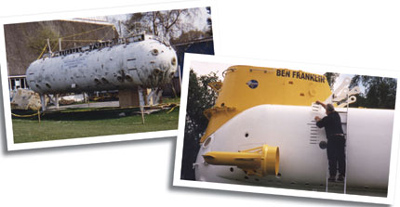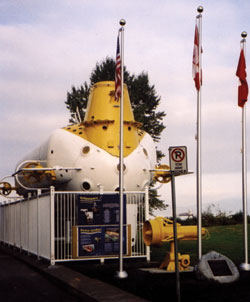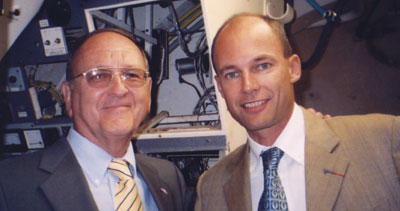|
|
 |
 |
 |
 |
|
FEATURESThey All Lived in a (White and) Yellow SubmarineBy Shira Boss-Bicak ’93
On July 14, 1969, Don Kazimir ’56 and five other crew members from prestigious circles of science locked themselves into a custom-built sub off the coast of Palm Beach, Fla. and set off on a historic underwater mission. Destination: unknown. On their 30-day expedition, which is believed to still rank as the longest underwater research dive, they drifted silently in the Gulf Stream in the Ben Franklin, so named for Franklin’s early study of the Gulf Stream. In addition to Kazimir, who joined the team as captain after leaving the Navy, were oceanographers from the British and U.S. navies, a NASA scientist, a Swiss engineer and celebrated inventor Jacques Piccard, who conceived the mission. The team studied the currents and ocean life in the raging underwater river, while inside, they themselves were the experiment. With its eye on space exploration, NASA wanted to test what would happen to mind and body when civilians were confined for a month. The mission went swimmingly: Grumman, the aerospace company that owned the sub and sponsored the research trip, sent out briefings on the progress. Down below, the men had a grand time listening to the newly released Beatles album Yellow Submarine. The drifting sub was mostly white with yellow trim, but it was still the closest anyone had come to living in a yellow submarine. When 30 days elapsed, the men emerged off the coast of Canada with a bundle of research in hand that, among other results, inspired five volumes from NASA, which still are in use. “NASA says that the biggest initial problem of extended voyage in space is biological — contamination. Bacteria are resilient, and they grow,” even in a supposedly decontaminated environment, says James Delgado, an underwater explorer and executive director of Vancouver Maritime Museum. “Where did they learn that? In the Ben Franklin.” The 1969 Gulf Stream Drift Mission capped off a decade when ocean exploration hit new highs of enthusiasm. “In the ’60s, there was phenomenal excitement about exploring the ocean,” says Gene Carl Feldman, who as a youngster was inspired by the mission to explore the oceans and now is a NASA oceanographer. “We were going to colonize the seabeds and get all kinds of untapped riches and food from them.” So how come hardly anyone who’s not in the field remembers the drift mission or the Ben Franklin, which Feldman calls “the icon of that period”? Two days after Kazimir and the team launched into the ocean, Apollo 11 launched into space, headed — unambiguously — for the moon. “It all just went away,” Feldman says of the interest in ocean exploration. There was still a good deal of publicity about the drift mission, but for the most part, the headlines were captured by the moon landing. “Nobody really cared, because everyone was looking at the moon,” Feldman laments. “The story of the Ben Franklin is known by serious oceanographers, a handful of people in NASA and some ocean historians,” Delgado says. “I hope that will change.” How it might change is that the Vancouver Maritime Museum recently salvaged the rusted carcass of the long-since abandoned sub. Delgado plucked its parts from a shipyard lawn and stationed the sub outside the museum, where volunteers have lovingly restored the outside and are working on the interior. It will be opened to the public this year and will be used for hands-on lessons about ocean exploration, from the Ben Franklin and before to present day.
As part of resurrecting the sub and constructing the exhibit, Delgado got in touch with Kazimir and other former crew members, who have contributed photos, documents, artifacts and knowledge of the sub and the mission. Last September, some of the crew and others involved in the mission, including Kazimir, assembled for a reunion and Ben Franklin dedication festival in Vancouver. Feldman also dug out his box of materials about the Ben Franklin that he collected in high school, and has built on his archive. He is working on a documentary about the mission, and a separate documentary is being put together by the Discovery Channel. Rather suddenly, while in his third career following captaining the Ben Franklin, Kazimir is being followed by a new wave of queries about the mission. “It’s often the unheralded who are the heroes of science,” Delgado says. “Kazimir and the others did something incredible that should not be forgotten.” Kazimir, who also has a 1957 degree in industrial engineering from the Engineering School, attended Columbia on a Navy ROTC scholarship. Following graduation, he spent nine years in the Navy, first on ships and then, after six months of sub school in Connecticut, on submarines, which he always had fancied. “They looked like big toys,” Kazimir says. “You know how boys are: They like their toys.” Despite enjoying the Navy — among other things, Kazimir took part in a 1961 spy mission in Russian waters off of the Kola peninsula — when he and his wife had their first of two daughters, Kazimir resigned to be closer to home. Fresh out of the Navy in 1967, he responded to an intriguing ad in The New York Times and got the job working on the drift mission. “I was fortunate to be involved in the experience,” he says. “It was a really exciting thing — cutting edge science.” Piccard, whose Swiss family had explored sea and air, had the idea that the best way to learn about the Gulf Stream would be to live in it: Get into it, drift with it and use observation and scientific equipment to study it. He got Grumman to build the sub and sponsor the mission, and Grumman hired Kazimir to contribute to the design of the sub, write the manuals and help man it. “This was a big research sub, and the first of its kind,” Kazimir says, “so we had to figure out the best way to run it — how to operate it, steer it, dive it, surface it, change depth and get it to neutral buoyancy so it’d stay at one depth.” Whereas most research subs go down for only a few hours, even today, the Ben Franklin was going for a month-long journey. “Livability was a big thing,” Kazimir notes. NASA became involved as part of its research for designing the Sky Lab, the first space station, which was constructed in the early ’70s. It wasn’t interested in the Gulf Stream’s behavior, but rather that of the men cooped up inside the sub. Feldman says his employer’s thinking was: “We’re going to lock these guys in a tin can for 30 days and have them do honest scientific work and monitor the hell out of them.” Their movements were recorded by cameras every two minutes. They wrote in journals, took psychological surveys and had their reflexes tested daily. The military had done these kinds of studies on subs (Kazimir had stayed underwater for as long as a month in the Navy, rising to periscope depth only to let off diesel exhaust and take on fresh air) but NASA suspected that non-military personnel, without military discipline and mindset, might react differently. Piccard decided to launch on July 14, the day Kazimir’s second daughter was born. Six men climbed aboard. Piccard led the scientific expedition and brought engineer Erwin Aebersold. Kazimir was the captain, Chester May was NASA’s representative, the British Navy sent Ken Haig, who worked with acoustics, and the U.S. Navy sent oceanographer Frank Buzzby, who was mainly interested in the Gulf Stream’s behavior.
Compared to a military submarine, the Ben Franklin had spacious and pleasant quarters. It was 50 feet long and 10 feet wide, with six large bunks and a nice living area. While in a Navy sub, the only way to look out is through the periscope, but the Ben Franklin had 29 windows, with lights to illuminate the waters. “Two of the bunks had a view port right above the bunk, and you could lie there and look out at the sea life,” Kazimir says. “The lights would attract zooplankton, which are like underwater bugs. They’d move around and it was like an underwater ballet — a beautiful sight.” As the team’s job was to drift, it was a smooth ride. Driving the sub meant controlling its depth, and Kazimir, Piccard and Aebersold took six-hour shifts. The sub was pulled along by the current at an average of 600 feet beneath the surface, averaging two knots (a little more than 2 m.p.h.). The motors were only employed one time, when the sub got stuck in a current that drew it out of the Gulf Stream. By underwater telephone, they stayed in contact with a support ship that accompanied them on the surface, and they were monitored by Navy airplanes flying overhead with sensors. The sub, the ship and the planes all collected data continuously. Before they left, Kazimir took charge of entertainment. He purchased a dart board, but then everyone looked at May from NASA: Nobody would be playing darts in space. So they came up with the Velcro dart board. Kazimir also bought a stack of music cassettes for the trip. “Music was very important,” he says. “Sometimes it got very cold and damp, and when you’re going along the bottom and worrying about hitting rocks and sunken ships for several hours, it makes you tense.” Enter: “Madame Butterfly.” When the work was done at the end of the day, the sub would come up from the bottom and drift without peril. The liquor cabinet would be unlocked for a rationed cocktail, the exterior lights would be turned on and with the opera playing, the men would station themselves at a view port and watch the marine life go by. Except when it didn’t just go by. Once, around dawn, two swordfish came into view. “They were ferocious. They attacked the view port right where the guys were watching,” Kazimir says. “Of course, they just bounced off it.” When the crew needed to be energized, Kazimir played show tunes or the crowd-pleasing “Yellow Submarine.” “We used to play that a lot,” he remembers. When he got back home, he bought the record to that and to “Madame Butterfly” and still listens to them to drift back to those underwater days. By August 14, the Ben Franklin had drifted 1,500 miles, and it emerged 330 miles southeast of Nova Scotia. The crew went to Washington, D.C., for a press conference at the National Press Club, and later to the South Street Seaport in New York for a ceremony, which is when Feldman found out about them. “I’d heard they were bringing in this sub,” he recalls. “I saw this really cool white sub and these guys in white suits jumping around on the deck, and I thought it was the coolest thing I’d ever seen and that I wanted to do that one day.” Kazimir and the crew participated in many interviews and spent about a year traveling and making presentations. But with the excitement over outer space, ocean exploration took a dive. Kazimir, with a partner, started a solar energy company, which he ran for the next two decades. In 1995, he went to work for the Catholic diocese of Palm Beach. The Ben Franklin went on a few local research trips after the drift mission, but research subs weren’t in much demand, and Grumman sold the sub in 1970 to a Canadian businessman. It was dissembled for shipping and not put back together again. “I was heartbroken,” Kazimir says. “For the rest of its life, it just sat there, deteriorating.” That is, until 1999, when the businessman donated the remains to the Vancouver Maritime Museum and its director, Delgado, spearheaded its restoration. “It remains an important analog for space travel,” Delgado says, “as well as an inspiring, immersive educational vehicle to encourage people to consider the ongoing exploration of Earth’s final frontier — the ocean.” Contributing writer Shira Boss-Bicak ’93 is a freelance journalist in New York.
|
|
||||||||||||||||||||||||||||||||||||||||||||||||||||||||||||||||||||


